
 |
Freethought & Rationalism ArchiveThe archives are read only. |
|
|||||||
|
|
Thread Tools | Search this Thread |
|
|
#1 |
|
Contributor
Join Date: Mar 2006
Location: Falls Creek, Oz.
Posts: 11,192
|
In his book Ante pacem: archaeological evidence of church life before Constantine (or via: amazon.co.uk) the author, Graydon F. Snyder, presents what others (here and elsewhere) have termed an exhaustive collection of the archaeological footprint of Christianity prior to the 4th century.
As many of you are aware, I have attempted to refute this evidence over the last few years in norder to explore the hypothesis that the Roman Emperor Constantine in fact was responsible for the sponsorship of the fabrication of the New Testament and the "Church History" which wa assembled by Eusebius of Caesarea between the years of 312 and 324 CE. Having obtained a copy of this work a few weeks ago, I have gone through this book in a meticulous manner to examine and review the detailed elements of the evidence assembled by Graydon Snyder with the view in mind to either find that I have been mistaken in exploring this hypothesis or to vindicate (at least to myself) the integrity of this hypothesis. The result of my critical review of the evidence presented by Graydon Snyder is that, as far as I am able to determine, it is quite reasonable to dismiss each and every citation therein presented, on a common sense basis. I have presented my findings, and the reasons by which I am unable to accept the view of Snyder and the mainstream "Early Christian History" tradition, that this evidence actually supports the tradition. The review I have conducted is quite exhaustive and runs to many pages and is thus not conducive to posing en masse in this forum. However I have collated all the references and citations presented by Snyder's monumental work in a web article entitled A Critical Review of Ante pacem: Archaeological evidence of church life before Constantine which I invite any interested parties to peruse at their leisure. I further invite anyone who may be interested in this issue to re-present any arguments that I have brought to bear in the assessment of this evidence, which I consider insufficient for the purpose of proving the historical existence of the Pre-Nicaean Christian church, alluded to in the writings of Eusebius and his subsequent continuators in the 4th and 5th century State Catholic Christian church. I will conclude this notice with one and one only example, and that is the claim by Graydon Snyder that in the archaeology of this "Early Epoch" there indeed are relics which depict the figure of Jesus. This example and image is as follows:  Plate 13 -- "The sarcophagus located in Sta. Maria Antiqua, Rome It is summarily described by the author as being "Likely the oldest example of Early Christian plastic art", and a full description is given is as follows: "The Teaching of the Law stands in the center, with a Good Shepherd immediately to the right and an Orante immediately to the left. Continuing left is a Jonah cycle, first Jonah resting, then Jonah cast out of the ketos, and finally Jonah in the boat. To the extreme left side stands a river god. To the right of the Good Shepherd there is a baptism of Jesus with a dove descending. Jesus is young, nude, and quite small next to the older, bearded John the Baptist. A pastoral scene concludes the right end" The Image of the Young Nude Jesus In a concluding section of his book Snyder remarks: "In fresco and plastic art Jesus is depicted as a youth, often nearly nude, who performed remarkable acts -- events described artistically in a New Testament context. This had appeared by 200 CE ........ 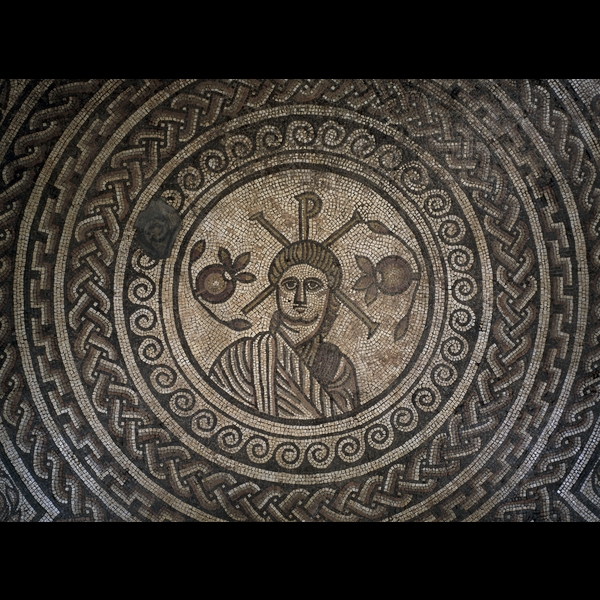 (Thanks Clive!) (Thanks Clive!)I find it extremely difficult to see this "young nude figure of Jesus standing beside John the Baptist, who wears the garb of the Greek philosophers". To my mind this image is simply of a man and his son, and the conjecture that we are looking at Jesus and John the Baptist is simply some utterly misdirected poetic licence. ("Christian Glasses") Anyway, I have been asked many times to recant this hypothesis that we have no pre-Nicaean evidence on the basis of the contents of Graydon Snyder's "ANTE PACEM" and have finally managed to locate the book and to conduct a critical and skeptical review of it. This task I have now competed, with the result that I can find no element of the archaeological evidence which does not rely upon such "Christian poetic licence". The "Orante" and the "Good Shepherd" occuring everywhere in "Early Christian art, etc" are non-christian! At the end of the day, I can find no evidence here (or elswhere) by which the hypothesis --- that there were no Christians before Constantine --- can be reasonably refuted. However, I welcome constructive criticism of my criticism, and hope to be proved wrong, so I can forget all about this ancient historical material, put my thesis down forever, and return to the present century, and live my life in blissful ignorance and peace. Both I and my surfboard have been missing routine workouts on the dawn patrol. |
|
|
|
|
#2 |
|
Contributor
Join Date: Mar 2004
Location: Dallas, TX
Posts: 11,525
|
I've stared at it for several minutes and can't for the life of me see a descending dove near the child figure. One thing I do notice though, is that neither the boy nor Jonas are depicted with a penis, though both are nude. These are surely then symbols from an ascetic Jewish cult, even if not Christian.
|
|
|
|
|
#3 | |
|
Contributor
Join Date: Mar 2006
Location: Falls Creek, Oz.
Posts: 11,192
|
Quote:
The ORANTE is somehow related to the "Mother Goddess of Life" and is generally taken to be a female figure with upraised arms. Many have interpretted this as related to the sould of the deceased. It is nearly always female. This fact in my mind -- let alone many others which I wont go into at the moment - rules out the scene being Jewish. There is another reason why the central Orante and the entire scene could not even remotely be claimed Jewish (or Christian). The following from Snyder: "[The Orante] occurred as the obverse of coins struck from the time of Trajan to the time of Maximian."This indicates we are simply looking at a Graeco-Roman scene on a Graeco-Roman sarcophagas for dead Graeco-Roman in the Graeco-Roman catacombs of Graeco-Rome. The retrospective "Christian Poetic Licence" is false This stuff is being presumed to be "christian" because the artistic assessors who are presenting this stuff to the reading public are wearing some standard issue "Christian Glasses". This one single instance of a retrospective "Christian Poetic Licence" is absolutely and totally representative of each and ever citation Snyder's work examines and discusses. The Literature and the Archaeology I know most people here are more interested in discussing the literary evidence and arguing about the manuscript tradition and the documents themselves (or translations thereof) however at ther end of the day it must be seen as entirely reasonable that we must also examine the integration of the archaeological evidence with the manuscripts. The archaeology is saying this evidence is not "evidence". This scene from the catacombs in Rome is certainly not either Christian or Jewish but is best explained as a Graeco-Roman scene featuring symbols which are shared on Graeco-Roman coins ---- familiar to the mind of the Graeco-Roman civilisation of the period c.200 to 400 CE. Is this assessment reasonable? |
|
|
|
|
|
#4 |
|
Contributor
Join Date: Mar 2004
Location: Dallas, TX
Posts: 11,525
|
|
|
|
|
|
#5 |
|
Veteran Member
Join Date: Jul 2008
Location: Location: eastern North America
Posts: 1,468
|
Both "Teaching of the Law" and "Orante" are wearing some sort of specialized head gear: caps or scarves.
Is such costume unique to Greece? Palestine? Persia? Egypt? Is it customary to be wearing such head gear in the summer time, judging from the attire, or lack thereof, in the other figures.... avi |
|
|
|
|
#6 | |
|
Contributor
Join Date: Mar 2006
Location: Falls Creek, Oz.
Posts: 11,192
|
Quote:
Off the top of my head .... it could be a Hercules figure "resting-in-peace" after his labors. It could be a Sol Invictus figure locked underground in the night awaiting another dawn. It could be any one of any of the stories associated with the figures mentioned in the official religion of the Graeco-Roman empire. Cambridge Ancient History Volume 12 |
|
|
|
|
|
#7 | |
|
Contributor
Join Date: Mar 2006
Location: Falls Creek, Oz.
Posts: 11,192
|
Quote:
 .... .... 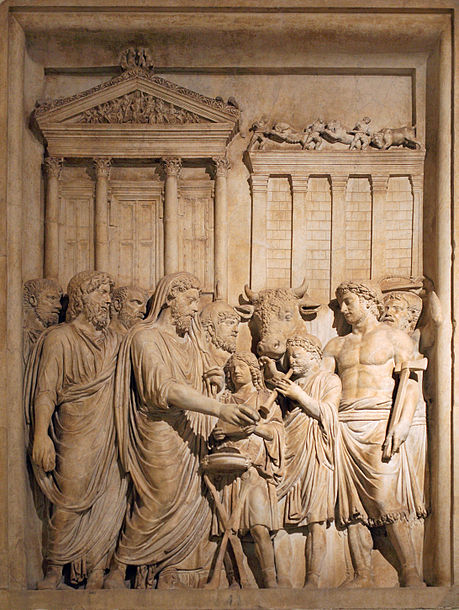 My first guess would be to associate it with the Graeco-Roman priesthood. |
|
|
|
|
|
#8 | ||
|
Veteran Member
Join Date: Jul 2008
Location: Location: eastern North America
Posts: 1,468
|
Quote:
Quote:
Here are a couple of other alternatives: history of headgear in persia. Here's a drawing of a similar, strange looking, headgear worn by Teaching of the Law, and an Orante. It is from ancient Egypt: In ancient Greece, we see a similar head covering, called "himation". Sometimes a man would wear only the himation (figure 4), and it was customary for philosophers and poets to dress in this manner. The illustration at the link above: "Himation around neck" appears very similar to my untrained eye, to the head gear worn by Teaching of the Law. In my opinion, there is nothing uniquely "christian" about this scene. avi |
||
|
|
|
|
#9 | ||
|
Contributor
Join Date: Mar 2006
Location: Falls Creek, Oz.
Posts: 11,192
|
There is also the standard Mithra head gear:
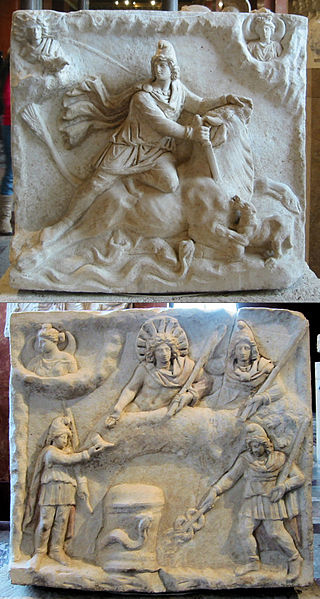 Quote:
Here are those exhibited as examples C, D and E. Do you see anything "christian" in these three inscriptions? Inscription "Evidence" p.119I can find nothing in these three inscriptions to unambiguously indicate the presence of a new testament reading author of the inscription. Can you? Can anyone? This seems to be on the surface --- again --- some sort of "Poetic Licence" which at liberty is being applied to the epigraphic evidence. The beginning of all this "orthodox christian" interpretation (in the modern sense) of the evidence from the catacombs (including the bones of St. Peter) takes us back to de Rossi and Pope Pious IX in the 19th century. Quote:
|
||
|
|
|
|
#10 | |
|
Contributor
Join Date: Mar 2006
Location: Falls Creek, Oz.
Posts: 11,192
|
THE ORANTE AND THE GODDESS IN THE ROMAN CATACOMBS by Valerie Abrahamsen
Quote:
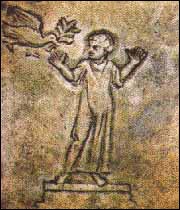 ... and ... ... and ... 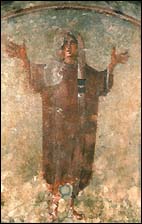
|
|
|
|
| Thread Tools | Search this Thread |
|